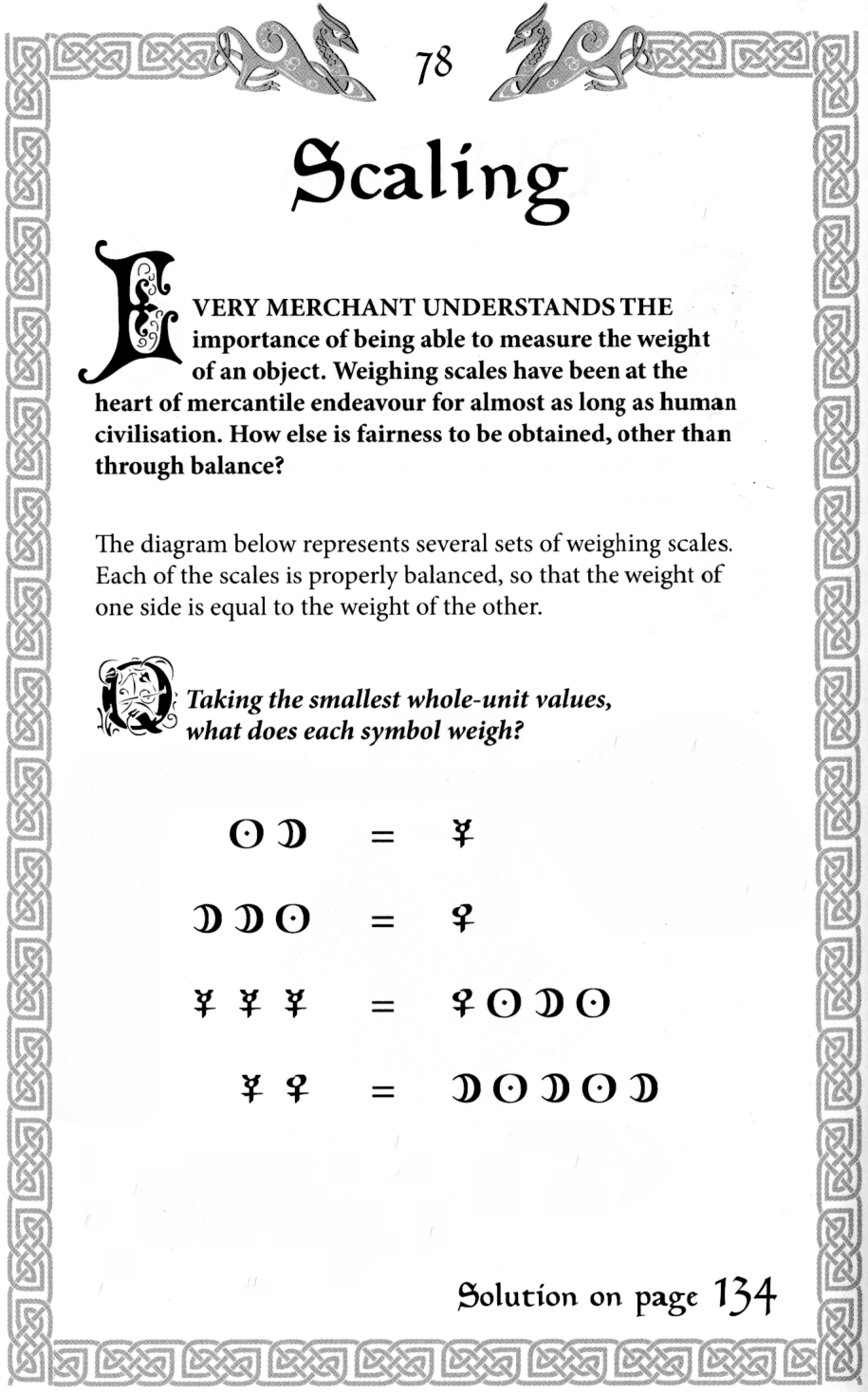The Medieval Puzzle Collection and homogeneous linear equations

The Medieval Puzzle Collection, A Fine and Perplexing Tome of Riddles, Enigmas and Conundrums, is one entry in a long list of Carlton published puzzle books by Tim Dedopulos. Similar titles include numerous Sherlock Holmes themed books, Tutankhamun’s Book of Puzzles and even A Game of Thrones Puzzle Quest.
I think this particular book, published in 2014, is a cheaper black-and-white reprint of the full colour The Medieval Puzzle Book from 2013. Suffice to say, Tim has churned out a lot of these books over the last 10 years, and there’s probably not a huge amount to tell between them.
Short version: I think this book is downright poor, though not quite as poor as The Great Global Treasure Hunt on Google Earth, also by Dedopulos. I don’t hate all his books – I quite enjoyed Sherlock Holmes’ Elementary Puzzles – but Medieval is both dull and badly edited. I’ll try to explain why, finishing with a mathematical foray into the world of homogeneous linear equations. Ready? Read on!
Dedopulos’ puzzle books follow a specific pattern: around 80 puzzles, one per page, in a strongly themed and neatly illustrated hardback book. A lot of the puzzles fall into well worn categories. Here are some examples from my imaginary Monty Python’s Far Too Silly Puzzle Book:
Family tree puzzles: “If my husband’s brother’s aunt marries my sister’s ex-parrot , what relationship to me is their second child?”
Logic puzzles: “If Alice says Bob is a liar and Bob says Carl’s father smells of elderberries… etc”
Time/distance/speed puzzles: “What is the average airspeed of a European swallow if it is laden for 2 thirds of a 20 mile journey?”
Probability puzzles: “If 3 of the shrubberies are green and 4 are brown and you randomly select 5 of them, will the Nights of Ni be pleased?”
Physics puzzles: “If I half submerge Mr Creosote in water and feed him a wafer thin mint, does the water level go up or down?”
Obscure answer puzzles: “How long do I wait before throwing the Holy Hand Grenade? Ah, ye must wait 10 seconds longer than half the time it takes the rabbit to eat Lancelot.”
The Medieval Puzzle Collection does feature some nice puzzles that avoid these stale categories, but there are too few of them to make the book worthwhile. Even if you’re new to these types of puzzles, most of them are repeated several times. By the end, you’ll be bored of solving slightly more complicated or slightly differently phrased versions of the same puzzle.
But the aspect that pushes The Medieval Puzzle Collection from mediocre down to poor is the bad editing as the book progress. In one puzzle, the answer is basically “explain Archimedes’ principle” which isn’t really a very interesting puzzle. To add insult to injury, the answer provided at the back of the book is perhaps the worst explanation I’ve ever had the displeasure of reading.
In another puzzle, you’re supposed to work out the distances between towns based on some limited information. Here, the problem is there is no unique solution unless you assume the towns are only separated by integer numers of miles.
And then there’s the puzzle below. See if you can work out what’s wrong with it?

It’s revealing that the answer at the back just says O=1, D=3, Legless Stickman=7, and Legless Stickman With Big Ears=4, but with no explanation of how to reach that answer. I’ll
The problem will be apparent to anyone with knowledge of homogeneous linear equations. These are sets of equations of where the sum of the variables in each equation is equal to zero. In this case (if I write Legless Stickman as ‘S’ and Big Ears as ‘E’), you get the following 4 equations:
O+D-E=0
O+2D-S=0
-2O-D-S+3E=0
-2O-3D+S+E=0
Equations of this type always have at least one answer: a trivial solution where all the variables are equal to zero. Sometimes, that’s the only solution. If the trivial solution isn’t the only solution, then there are an infinite number of possible solutions.
You can quickly test this out with this puzzle. Try O=1 and D=2, and the first equation tells you E=3, while the second equation tells you S=5. Plug those numbers into the last two equations and they work out. You can express that solution as (1,2,3,5).
Indeed, you can pick any numbers you want for O and D, which fixes E and S and all four equations will always work out. The solutions are all of the form (O,D,O+D,O+2D).
It’s clear Dedopulos realised something was wrong because his question reads “Taking the smallest whole-unit values…”, suggesting he noticed there was more than one answer. But why he chose (1,3,4,7) as the “correct” answer is a complete mystery. Even my first random choice of O=1 and D=2 produces an answer set which is “smaller” in any meaningful way.
If you assume none of the values are zero (or less!), and that each symbol represents a different number, then you actually get the “smallest” whole-unit answer if O=2 and D=1. The solution is then (2,1,3,4), which is obviously the smallest set of 4 different integers greater than zero. As it stands, I can’t begin to guess at what Dedopulos was trying to achieve with this puzzle or how this error occurred.
Hopefully this takedown of The Medieval Puzzle Collection has been an enjoyable read. It certainly helped me work out my frustrations at what I initially thought would be a diverting book, but quickly turned into tedium and then odium.